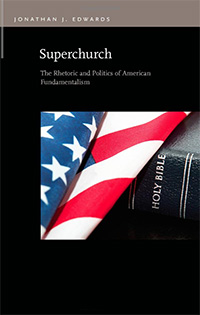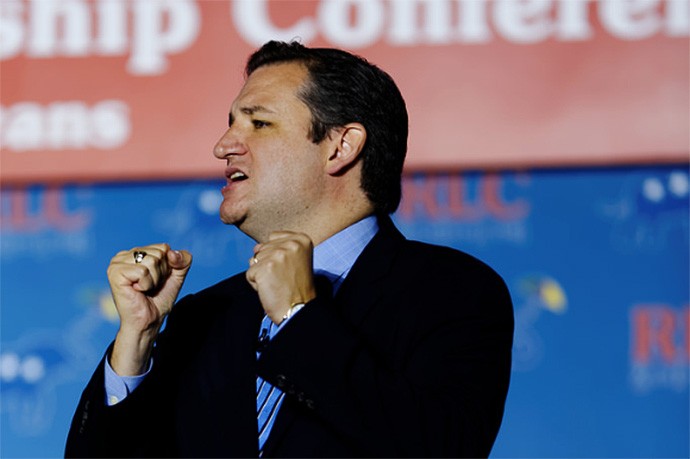When Texas Senator Ted Cruz announced his presidential candidacy this spring he urged conservative voters to claim their power—”I want to ask each of you to imagine, imagine millions of courageous conservatives, all across America, rising up together to say in unison ‘we demand our liberty.’” This rhetorical move, in which conservative Christians are cast as both oppressed minority and a latent majority, is a timeworn trope. But recognizing this language and how it works is key to understanding the way fundamentalist religion operates in politics.

Superchurch: The Rhetoric and Politics of American Fundamentalism
Jonathan J. Edwards
Michigan State University Press, April 2015
Eric Miller: What prompted you to write a book about fundamentalism? For starters, it’s a pretty slippery term.
Jonathan J. Edwards: This project started out at Northwestern University as a dissertation proposal on the political influence of American megachurches, but I discovered pretty quickly that, in and of themselves, megachurches were not nearly as interesting (or unique) as they seemed at first. What did interest me was a narrative tension that kept popping up in my research between local churches and a constructed “enemy,” variously described in terms of ecumenical federation, superchurch confederacy, a world church, and secular humanism.
As I studied further, it became clear that, while some authors had fixated on some of the more public aspects of this tension (e.g., the Moral Majority vs. secular humanism in the late 1970s), no one had studied its roots and evolution in depth. That became the focus of my eventual dissertation project and ultimately this book. By focusing on how the tension evolved, I’m able to provide more comprehensive (and hopefully more persuasive) explanations for the relationships that exist between the religious beliefs and political demands of Christian conservatives.
As for the word fundamentalism, “slippery” is a pretty good way to describe it. For practical purposes, there are two relevant definitions. On the one hand, fundamentalism refers to a specific movement within Protestant Christianity, which coalesced around a set of inter-church disputes in the early twentieth century. For my work, that definition includes groups who call themselves “fundamentalists,” but it also includes contemporary Christian evangelicals who would reject the label but who are—knowingly or not—party to the same disputes and tensions.
On the other hand, fundamentalism has become a kind of catch-all term for describing movements or orientations that are both politically significant and militantly irrational.
Basically, it’s a word we use to denigrate perspectives and people we don’t like.
Usually this second definition is linked with religion—as when people talk about Islamic fundamentalism—but not always. For example, you’ll see authors who write about market fundamentalism or political fundamentalism. All this is confusing, and that’s part of the reason many authors choose to save themselves the trouble and avoid the term altogether.
Despite the difficulties that the term presents, however, the concept of fundamentalism is important to me for a couple of reasons.
First, it more clearly highlights the stakes for many Christian conservatives who enter into politics. When fundamentalists and evangelicals rally against abortion or same-sex marriage, for example, it’s not primarily about their right to stand on a street corner and preach good news to the unconverted. It’s about their right to authoritatively define the fundamentals of truth and public morality, based on an authoritative interpretation of an authoritative Bible.
The truth-demands of fundamentalism stand in sharp contrast to notions like compromise and pluralism, and that’s a contrast that a term like “evangelical” doesn’t quite capture.
Second, perhaps in part because of its slipperiness, the term can help us to think broadly about the disputes and tensions that each and every one of us have to navigate as we struggle to communicate with, live with, and govern with one another.
As democratic citizens we all have to ask ourselves: What is fundamental? And who decides?
In a deliberative democracy, compromise is a value, but for hardliners it is often viewed as a character flaw. Many of us think of fundamentalists as people who can’t be reasoned with, which is a problem for democratic politics. But you reassert fundamentalism as a “church movement” first and foremost, representing localism against “superchurch” ecumenism. How does that translate to politics?
It’s important to understand, as I argue in the book, that fundamentalism is a paradox. Fundamentalists describe themselves as both marginalized and a majority. They speak of national revival and theocratic dominion, but both are always deferred. They celebrate local victories while announcing imminent national destruction. This paradox is rhetorical—meaning that it’s constructed in and through language. I’m a student of rhetoric and, in this book, I’m not particularly interested in whether fundamentalists “really” represent localism or really speak as an oppressed minority. What’s important is that they say they do, and this paradoxical claim drives and justifies political action.
In the book, “superchurch” is one of the words that speaks to this paradox in fundamentalist rhetoric. There was a big push for Protestant unity in the immediate aftermath of World War I, and many of the early fundamentalist leaders denounced ecumenical organizations like the Federal Council of Churches and the Interchurch World Movement as elements in a “super church confederacy” that would eliminate denominational distinctions and eventually destroy “Bible-believing” churches altogether.
There was a kernel of truth in these arguments; some ecumenical leaders were pushing, for example, to consolidate under-staffed rural churches by merging congregations from different denominations. But this kernel of truth became part of a much larger narrative in which national religious and political leaders were joining together to crush local churches and outlaw fundamentalist belief. This narrative, in turn, has continued in different guises over the past century—linked with apocalyptic fears of communism, secularism, environmentalism, socialism, and so forth.
The flip-side of this narrative, however, was that of churches that resisted. Magazines published anecdotes about local pastors who stood up to ecumenicists and local churches that broke away from their corrupted denominations. Fundamentalist publications began celebrating large, independent churches as islands of local resistance. By the 1960s, pastors like Jerry Falwell had begun arguing that local, “superaggressive” churches could “capture” their communities for Christ, reform local politics to reflect fundamentalist authority, and become media centers for global evangelism. These fundamentalist “superchurches” would eventually provide the foundation for national political organizations like the Moral Majority in the late 1970s.
Of course, even as fundamentalists have become more nationally visible and politically active, the paradox remains. Just a couple of months ago, for example, when Senator Ted Cruz announced his candidacy for president at Falwell’s Liberty University, he encouraged Christian conservative voters to think of themselves as both an oppressed minority and an untapped majority. He described the federal government as a monolithic and mischievous force that crushes the dreams of small business owners, the relationships between individuals and doctors, the rights of parents, and the freedom of religious believers. At the same time, he spoke of “millions of courageous conservatives” and “born again Christians” whose votes could restore an idealized constitutionalism and drive the big-government bureaucrats out of the American temple.
Part of my goal in Superchurch is to help us better understand the history and context behind arguments like Cruz’s, so we can develop a better sense of how and why they continue to resonate with so many fundamentalist and evangelical voters.
The link between Liberty and Cruz is interesting, since it comes at a time when both the church and the GOP are pretty unpopular with young people – or so the polls tell us. In your view, can this unpopularity be in any way attributed to the rise of fundamentalist superchurches?
That’s a good question. Throughout the twentieth century, there have been disputes between and among fundamentalist and evangelical communities. Often those disputes are generational and come down to questions about fundamental values and the proper relationship between believers and outsiders.
In the last chapter of the book, I turn from the fundamentalist superchurches represented by leaders like Jerry Falwell to the evangelical megachurch movement that was most prominent in the 1990s and early 2000s. Megachurches like Willow Creek Community Church in Chicago are designed to attract young people, and they’ve worked hard to present themselves as anti-fundamentalist in a number of ways. They appeal to individual experiences of spirituality over rigid doctrinal statements. They use words like “seekers” rather than talking about lost or damned souls. They also tend to avoid rigid political platforms.
If you walk through the multiple parking lots at Willow Creek, you can spot bumper stickers that span the political spectrum, and megachurch pastors have advised both Republican and Democratic presidents.
Of course, all of this exists on a spectrum. Some megachurches are much more explicitly conservative (or liberal) than others, and factors like location, denominational commitments, and the ethnic makeup of a congregation play big roles. But, beginning in the late 1980s, the general trend in megachurches seemed to be a shift toward a more accommodating and less rigid approach to both doctrine and politics.
In looking at these churches, I’m most interested in how they balance accommodation with a desire to maintain fundamental beliefs and distinctions related to the inerrancy of the Bible, the uniqueness of Christianity among religions, the reality of hell, and doctrines about sexuality, marriage, gender norms, economic values, and so forth.
For many megachurches, there’s an irresolvable tension between “taking the Bible seriously” on the one hand and not appearing rigidly fundamentalist or conservative on the other. Some seem to square this circle more effectively than others—usually by incorporating lots of programmatic variety and appealing to individual judgment—but it’s a continual process of negotiation.
So, back to some of the polls you mentioned. There seems to be pretty good evidence that a lot of younger people are losing interest in packaged and branded institutions. If I had to frame it in terms of the language I use in this book, I’d say that “the local” is back in vogue. Many younger people are moving out of the planned suburbs where megachurches thrived and back toward urban centers. They seem more interested in local food, mobile technologies, and their ecological footprints. The GOP is in trouble, but there’s evidence that the Democrats are too. Support for both civil and economic libertarianism appears to be on the rise among younger voters, while “organized religion” and “big government” are increasingly troubled terms. When megachurches first emerged, they claimed to stand against a rigid, politically problematic, and overly doctrinal fundamentalism. Whatever comes next will claim to stand against the visibly concentrated wealth and packaged programs of the megachurches.
None of this spells the death of fundamentalism, but it does mean that the fundamentalism of the next few decades will look different than it did ten or twenty years ago. Some of the doctrines, and certainly the methods and approaches will have to change. Indeed, some changes are already evident. For example, Robert Glenn Howard, in his excellent book Digital Jesus, demonstrates how definitions of both fundamentalism and the church have been altered by the influence of internet-based conceptions of community.
I expect more of that to continue, and I suspect that the success or failure of the new fundamentalism will depend on how successfully they can create new versions of the old, paradoxical narratives of local communities and local resistance.
I wonder if you could say a bit more about those next few decades. Having traced this history from the early 20th century to the early 21st, can you make any predictions about where fundamentalism is headed in the future?
Predictions are always difficult but, beyond what I have already said, I’m willing to make a couple of broad claims.
First, fundamentalism is not going away. Whether we define it narrowly as a Protestant sectarian movement or more broadly as religious or religiously-tinged radicalism, it’s quite clear that fundamentalist disruptions will continue. Throughout much of the twentieth century, one of the guiding assumptions of political theory was that more economically and infrastructurally advanced countries would inevitably become more secular. Today, researchers tend to recognize that the situation is more complex. As global connectivity increases, religious belief continues to wield tremendous influence.
Religious voices and images flood public media; political leaders seek out religious audiences and institutions; and religious leaders enjoy growing political influence around the world. Many religious beliefs and communities are easily adaptable to European or American-style secular politics, but others are not. As scholars, students, and citizens, we have a responsibility to take serious account of religious fundamentalisms and fundamentalist arguments as we collectively determine what the limits, exclusions, and fundamentals of our collective politics can and should be.
Second, fundamentalism is and will remain strongest at the level of local politics. National candidates and organizations inevitably generate the most press, but if you want to understand fundamentalist politics, look at local school board elections, local fights over the public display of religious memorials, local pastors who challenge IRS rules against endorsing political candidates, and the religious exemption claims of local business owners. A few of these struggles make national headlines—the recent firestorm over Indiana’s Religious Freedom Restoration Act comes immediately to mind—but most do not. Nevertheless, they are the essence of fundamentalist political engagement.
Just as Christian fundamentalists emerged by idealizing local churches as temples and fortresses against oppressive denominations, today they idealize small towns, schools, and businesses as fortresses against an ongoing national and global slide toward anti-Christian secularism. For non-fundamentalists and particularly for those who study fundamentalism, the challenge moving forward is to pay more attention to the complexity of these local communities and debates.
Ultimately, I didn’t arrive at the end of this project with an optimistic sense that we are all going to start getting along anytime soon.
I think, for example, that fundamentalist arguments regarding issues like same-sex marriage will largely dissipate over the next few decades, but debates over issues like national boundaries, environmental regulations, religious minorities, fetal identity, economic redistribution, and so forth will continue and even intensify. Fundamentalists and non-fundamentalists will both continue to evolve, of course, but, short of a fundamentalist-style apocalypse or a (to my mind) highly undesirable shift away from the messiness of pluralism and democracy, I don’t anticipate the divisions going away.
That said I do hope that, as we learn more, we can argue better and find more ways to create effective debate and build effective consensus with one another.





